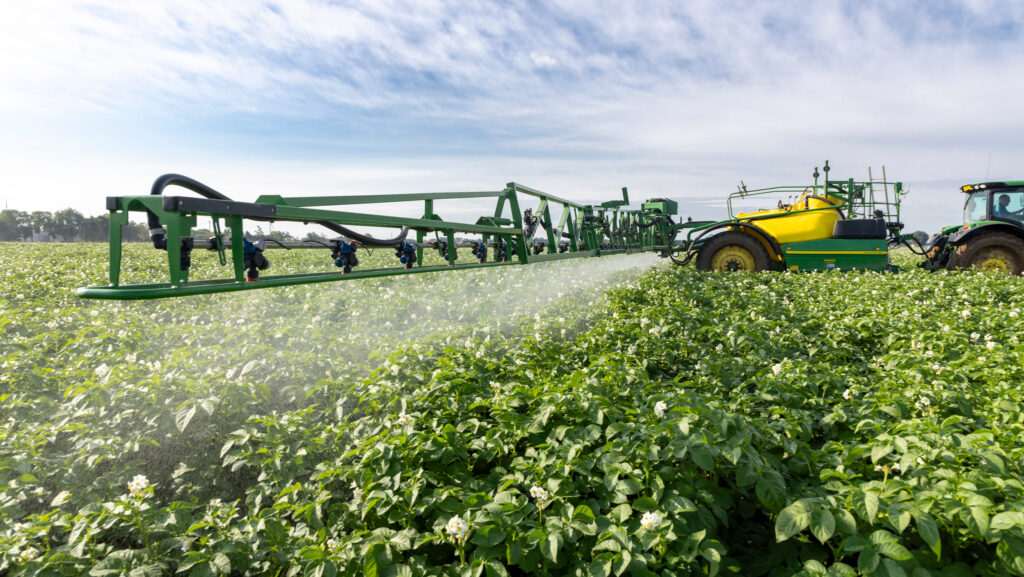Potato growers advised to stock up mancozeb for new strain
 © GNP
© GNP Potato growers are being advised to stock up on the multisite fungicide mancozeb before sales end on 30 November, to help manage resistance risk next season.
The advice follows confirmation that the 46_A1 strain of late blight with multiple resistance to fungicides has been detected in a sample collected in Ceredigion, Wales.
This strain has demonstrated resistance to both the CAA group of fungicides, including mandipropamid, and the OSBPI group that currently consists of oxathiapiprolin.
See also: Potato blight – what UK farmers can learn from Europe
The discovery was made just 130 miles east of County Carlow in Ireland where 43_A1 was confirmed in 2023.
This strain, along with 46_A1, were the dominant strains of the disease in the Netherlands in 2023, which was one of the worst late blight seasons.
Dutch growers saw rapid disease spread, and by July, they were unable to manage it for the rest of the season.
Welsh site
The infected sample was found at the Adas trials site at Lampeter in a crop of King Edward grown from Scottish seed stock.
Although there is no definitive explanation for how the clone came to arrive at Lampeter, the most likely answer is on the wind, says Eric Anderson, Scottish Agronomy senior agronomist.
Praise, he says, must go to the Adas team for being alert to the appearance of a new late season infection and submitting it to the Fight Against Blight programme for testing.
“Blight spores are highly mobile and there are documented cases of them being carried on the wind for long distances.
“It is possible that spores were carried on a vehicle or footwear, but this seems unlikely in this instance so windborne transmission is the most likely source of transmission,” Eric says.
2025 strategy
The arrival of the 46_A1 strain raises the need for growers to practice effective resistance management policies, says Eric.
“Mancozeb is widely regarded as a valuable mixing partner conveying good protection against alternaria and as a tank mixer for protecting other modes of action against late blight.
“With only a few weeks left before it is formally withdrawn, growers should see the arrival of 46_A1 as a reminder to secure stocks for use in 2025,” he says.
Sale and supply of any plant protection product containing mancozeb must take place prior to 30 November 2024, and the use-up date is 30 November 2025.
“Forward planning of late blight protection programmes, compliant with [Fungicide Resistance Action Committee] and manufacturers guidance is becoming increasingly complex,” says Eric.
“There is a correlation, but no direct genetic link between genotypes (genetic makeup) and phenotypic traits of potato late blight.
“For example, variation in fungicide resistance has been observed in the 43_A1, 46_A1 and 36_A2 variants on the continent.
He believes in the future, it will be important to understand the evolution of genotypes and different phenotypic variants in the same genetic group and apply this information to future integrated crop management strategies.
“We need greater emphasis to be placed on phenotyping of both late blight and alternaria.”
Plant resistance
Another concern is the documented cases of the more aggressive late blight clones found in recent seasons demonstrating the ability to break the plant’s resistance genes.
“Variety resistance to late blight is less useful in the face of a diverse and aggressive population of late blight that has been demonstrated to be capable of breaking resistance genes.
“This makes the published variety resistance ratings of little value to blight management strategies,” he says.
This means plant protection products should be used to support resistance genes rather than relying on them as the primary method of protection, he says.
“The landscape has changed, and we need to adapt. In the fast moving and dynamic situation, we face, we need to understand how to make the most of all the tools we have available.”
Eric adds that the discovery of 46_A1 in Great Britain also highlights the value of Fight Against Blight and the need for the industry to work towards the collective good.
The Fight Against Blight (FAB) scheme
First launched in 2006, the scheme monitors Phytophthora infestans populations via a nationwide network of agronomists, growers, and industry representatives (the FAB Scouts).
This network annually submits up to 1,500 field samples from suspected late blight outbreaks throughout Britain.
The work, led by Dr David Cooke and Dr Alison Lees from The James Hutton Institute, includes both the annual sampling of late blight outbreaks, the characterisation of pathogen populations, as well as fungicide sensitivity testing on active ingredients prioritised by the industry.
Funding for the 2024 season was provided by an industry consortium comprising Certis Belchim, UPL, BASF, Bayer, Corteva, Syngenta, Albert Bartlett, Agrovista, Frontier, Hutchinsons, GB Potatoes, McCain, Scottish Agronomy, The Seed Potato Organisation, Agrico, Branston, SAC Consulting and Agrii.

